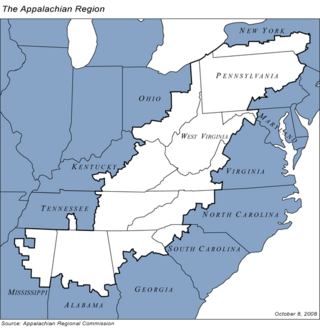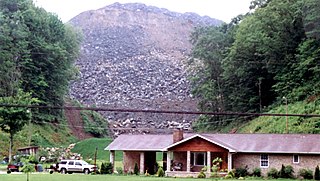
The United Mine Workers of America is a North American labor union best known for representing coal miners. Today, the Union also represents health care workers, truck drivers, manufacturing workers and public employees in the United States and Canada. Although its main focus has always been on workers and their rights, the UMW of today also advocates for better roads, schools, and universal health care. By 2014, coal mining had largely shifted to open pit mines in Wyoming, and there were only 60,000 active coal miners. The UMW was left with 35,000 members, of whom 20,000 were coal miners, chiefly in underground mines in Kentucky and West Virginia. However it was responsible for pensions and medical benefits for 40,000 retired miners, and for 50,000 spouses and dependents.

Appalachia is a cultural region located in the central and southern sections of the Appalachian Mountains of the Eastern United States. It stretches from the western Catskill Mountains in the east end of the Southern Tier of New York State west and south into Pennsylvania, continuing on through the Blue Ridge Mountains into northern Georgia, and through the Great Smoky Mountains from North Carolina into Tennessee and northern Alabama. In 2020, the region was home to an estimated 26.1 million people, of whom roughly 80% are white.

The Appalachian Regional Commission (ARC) is a United States federal–state partnership that works with the people of Appalachia to create opportunities for self-sustaining economic development and improved quality of life. Congress established ARC to bring the region into socioeconomic parity with the rest of the nation.

The Battle of Blair Mountain was the largest labor uprising in United States history and the largest armed uprising since the American Civil War. The conflict occurred in Logan County, West Virginia, as part of the Coal Wars, a series of early-20th-century labor disputes in Appalachia. Up to 100 people were killed, and many more arrested.
The Canadian Mineworkers Union (CMU) was a Canadian trade union of coal miners based in Cape Breton Island, Nova Scotia. Although it never won an election or legally represented workers, it was part of an important movement among Canadian unions in the 1980s to break away from their international American counterparts.
The Bituminous coal strike of 1974 was a 28-day national coal strike in the United States led by the United Mine Workers of America. It is generally considered a successful strike by the union.
The Bituminous coal strike of 1977–1978 was a 110-day national coal strike in the United States led by the United Mine Workers of America. It began December 6, 1977, and ended on March 19, 1978. It is generally considered a successful union strike, although the contract was not beneficial to union members.
Arnold Ray Miller was a miner and labor activist who served as president of the United Mine Workers of America (UMWA), AFL–CIO, from 1972 to 1979. Winning as a reform candidate, he gained positive changes for the miners, including compensation for black lung disease. He had difficulty dealing with growing internal union opposition. His last two years as president were particularly tumultuous and he suffered two heart attacks, finally resigning in November 1979 with the title of "president emeritus for life".
Samuel Morgan Church, Jr. was a coal miner and president of the United Mine Workers of America (UMWA) from 1979 to 1982.

In the United States, the Hillbilly Highway is the out-migration of Appalachians from the Appalachian Highlands region to industrial cities in northern, midwestern, and western states, primarily in the years following World War II in search of better-paying industrial jobs and higher standards of living. Many of these migrants were formerly employed in the coal mining industry, which started to decline in 1940s. The word hillbilly refers to a negative stereotype of people from Appalachia. The term hillbilly is considered to be a modern term because it showed up in the early 1900s. Though the word is Scottish in origin, but doesn't derive from dialect. In Scotland, the term "hill-folk" referred to people who preferred isolation from the greater society and the term "billy" referred to someone being a "companion" or "comrade". The Hillbilly Highway was a parallel to the better-known Great Migration of African-Americans from the south.

Appalachia is a region of the Eastern United States. Home to over 25 million people, the region includes mountainous areas of 13 states: Mississippi, Alabama, Pennsylvania, New York, Georgia, South Carolina, North Carolina, Tennessee, Virginia, Kentucky, Ohio, Maryland, as well as the entirety of West Virginia.
The Pittston Coal strike was a United States strike action led by the United Mine Workers Union (UMWA) against the Pittston Coal Company, nationally headquartered in Pittston, Pennsylvania. The strike, which lasted from April 5, 1989 to February 20, 1990, resulted from Pittston's termination of health care benefits for approximately 1,500 retirees, widows, and disabled miners. The strikers also cited the refusal of the company to contribute to the benefit trust established in 1950 for miners who retired before 1974 and the refusal of the company to bargain in good faith as grounds for their action. The company cited declining coal prices, decreasing demand, and recession as its reason for limiting health care benefits.
Born in Toledo, Ohio, in 1909, Lorin Edgar Kerr was educated at the University of Toledo where he received his B.A. in 1931 and at the University of Michigan, receiving his M.D. in 1935 and a M.S.P.H. in 1939. From 1937 to 1944 he served in municipal and county public health departments in Ohio and Michigan. Kerr joined the United States Public Health Service in 1944, first in the War Food Administration and later in the Industrial Hygiene Division. While with the Industrial Hygiene Division he provided consultant services for labor unions which were then beginning to develop their own medical care programs.

Environmental justice and coal mining in Appalachia is the study of environmental justice – the interdisciplinary body of social science literature studying theories of the environment and justice; environmental laws, policies, and their implementations and enforcement; development and sustainability; and political ecology – in relation to coal mining in Appalachia.

Environmental issues in Appalachia, a cultural region in the Eastern United States, include long term and ongoing environmental impact from human activity, and specific incidents of environmental harm such as environmental disasters related to mining. A mountainous area with significant coal deposits, many environmental issues in the region are related to coal and gas extraction. Some extraction practices, particularly surface mining, have met significant resistance locally and at times have received international attention.
Bituminous Coal Operators Association (BCOA) is a coal mining lobbying organization. It was founded in 1950 by various companies to deal with the UMWA and unionizing of mines during the change from human labor to mechanical labor. The BCOA would strike deals between miners, mine companies, and coal buying companies to provide a steady flow of continuous labor and a steady purchasing price for coal. The main deals normally contained negotiations of some miners being put out of work by mechanizations while the miners left would be guaranteed a steady job and pay as long as they agreed to not hold up progress with strikes and other activities. In addition, the BCOA hears requests from the UMWA employees for pay raises but often results in unprotected employees being laid off after a deal has been reached. The current president of BCOA is David M Young. He is the main representative for the BCOA and lobbyist.
The Coal Employment Project (CEP) was a non-profit women's organization in the United States from 1977–1996 with the goal of women gaining employment as miners. With local support groups in both the eastern and western coalfields, CEP also advocated for women on issues such as sexual harassment, mine safety, equal access to training and promotions, parental leave, and wages.

The 2021–2023 Warrior Met Coal strike was a failed labor strike in Alabama, United States. The strike began on April 1, 2021 and involved members of the United Mine Workers of America striking against Warrior Met Coal Inc. Warrior Met was formed after the bankruptcy of Walter Energy and operates coal mining facilities in the state. The strike was over the failure of the union and company to agree to a labor contract for the approximately 1,100 union members who work for Warrior Met. UMWA International President, Cecil Roberts ultimately failed to achieve the strike's goals, leading to losing over 50 percent of the Union membership at Warrior Met.
The 1959 United Mine Workers strike was a labor action by union miners in Eastern Kentucky. Originally over a pay increase, it grew into a conflict between union and non-union mines that resulted in three deaths. It was the first instance of labor violence in the area since the Harlan County War and was the prelude to the Roving Picket Movement.
Miners for Democracy was a dissident movement within the United Mine Workers of America which created successful reform in the union's administration of the union in the early 1970s. It was organized in Clarksville, Pennsylvania in April 1970 after the funeral of Joseph ‘‘Jock’’ Yablonski, after the current president hired assassins for his murder. MFD formed with the mission to challenge the UMWA's current administration, decentralize the union and bring power back to the rank-and-file miners. MFD worked closely with the Black Lung Association (BLA), who also openly opposed the Boyle administration. BLA formed in 1969 and lead by Arnold Miller and Charles Brooks, and Miller would later be chosen by MFD as a candidate to replace Boyle as president during union reform. Mike Trbovish, who was chairman of MFD, became the vice president of the union under the Miller administration.










